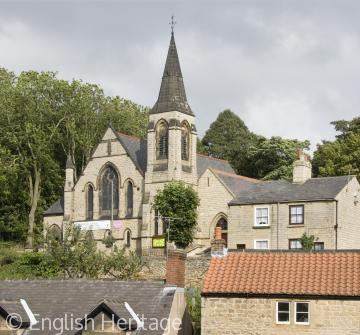Nonconformity
 The Trinity Methodist Chapel, Hill Top, Bolsover opened in 1897 with seating for 500 people
The Trinity Methodist Chapel, Hill Top, Bolsover opened in 1897 with seating for 500 peopleDuring the Middle Ages the Western Catholic Church imposed a single system of belief, which was enforced by a complex hierarchy of clergy, bishops and other Church officials ultimately answerable to the pope. Dissenting views were automatically defined as heresy, punishable by excommunication, imprisonment and in some cases death by burning. Even so, intellectuals such as John Wycliff occasionally challenged Church orthodoxy in the universities, and by the late 15th century Wycliffite groups such as the Lollards had established close-knit informal networks in some areas, exchanging illegal books and ideas, and often intermarrying. Their social status ranged from influential gentry to obscure artisans, though particular support came from the wealthy commercial and trading classes who enjoyed strong links with the Continent.
In England, the 16th-century Reformation saw a transition to a new Protestant religion which embodied many of the religious convictions of the Lollards. But this was still a centrally controlled state religion, in which the new religious orthodoxy was imposed just as ruthlessly as earlier, and arguably more efficiently. Catholicism, still the state religion in much of Continental Europe, was viewed with particular paranoia, particular after the Gunpowder Plot of 1605.
During the earlier 17th century, a variety of divergent Protestant views began to emerge amongst those who thought that the Elizabethan religious settlement did not go far enough. Even so, it was not until after the Civil War and Charles II's Restoration that the first very limited steps were taken towards legalising religious pluralism. Dissenters (those who refused to accept the reintroduction of bishops and the official Prayer book) were sporadically allowed to hold licensed meetings or conventicles, and the Compton Census of 1676 estimated that at least 4% of the population were Dissenters, with far higher proportions in some places. From 1689, after the 'Glorious Revolution', Dissenters could license their meeting houses for public worship at the Quarter Sessions, though they remained debarred from public office until the repeal of the Test and Corporation Acts in 1828.
The earliest Dissenting groups, firmly established by the late 17th century, were the Friends or Quakers, the Baptists, the Presbyterians, and the Independents (later Congregationalists). The distinction between some of these groups is not always clear-cut, particularly when viewed through Anglican Church records. Collectively, they are often referred to as Old Dissenters, to distinguish them from the wave of 'New Dissent' which followed in the mid 18th century. The largest and most influential new body was the Wesleyan Methodists, though the term 'New Dissent' also covers an Evangelical revival among some older groups in the later 18th century. A breakaway Baptist New Connection was formed in 1770, and a Methodist New Connection in 1797, while the Primitive Methodists broke away in 1812, becoming especially popular among the labouring classes. Throughout, nonconformity was generally associated with Liberal and sometimes radical politics.
During the 19th century nonconformity (by then the preferred term) became an important issue in public life, fuelling debates about funding of education and Disestablishment of the Anglican Church. Its influence varied greatly both regionally and locally, with some town corporations (particularly in industrial areas) and even some rural villages dominated by nonconformity for much of the century. Over all, the ecclesiastical census of 1851 showed that nonconformists made up nearly half of the church-going population, and that in no one county did they comprise under a third.
Roman Catholic emancipation came rather later, a result in part of the strong if intermittent popular anti-Catholic feeling manifested in events such as the Gordon Riots in 1780. For much of the late 16th and 17th centuries Catholics remained a small and persecuted minority, subject to a range of heavy penalties including fines, forfeiture of property, and imprisonment. Some, unsurprisingly, maintained minimum attendance at church to avoid the worst penalties. By the 18th century the law was generally imposed less harshly, but legal handicaps remained until the Catholic Emancipation (Relief) Act of 1829. A few Catholic chapels were built from the late 18th century, particularly in the north of England, and in 1850 twelve Roman Catholic dioceses were created, causing uproar among some elements of the Protestant population.









